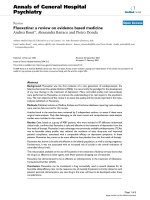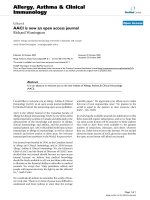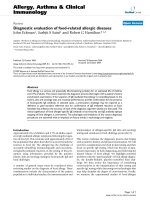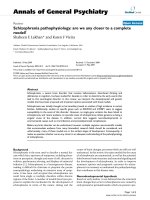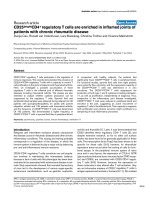Báo cáo y học: "Why aren’t we practising homogenized medicine" docx
Bạn đang xem bản rút gọn của tài liệu. Xem và tải ngay bản đầy đủ của tài liệu tại đây (32.61 KB, 2 trang )
Page 1 of 2
(page number not for citation purposes)
Available online />Abstract
Why is the practice of intensive care so heterogenous?
Uncertainty as to ‘best practice’, conservatism, and complacency
may all contribute to our divergent management strategies. The
need for further generalisable research, anonymised audit, external
peer review and open access databases is discussed.
Lauralyn McIntyre and colleagues [1] have neatly used a
septic shock scenario-based survey to highlight considerable
variations within Canadian critical care practice. They
acknowledge the potential pitfalls of translating survey results
into ‘real life’; however, my own experience of the diversities
within UK practice suggest this would be representative of at
least one other industrialized country, albeit with some
variation in the detail (for example, use of gelatin as a plasma
expander is much commoner in Europe).
They found decisions regarding treatment strategy (choice of
fluid, use of inotropes and transfusion triggers) to be highly
variable. However, they did demonstrate consistency in a
continuing reliance on ‘basic’ monitoring (blood pressure, heart
rate, central venous pressure, urine output, pulse oximetry). This
was to the relative exclusion of other, more sophisticated tech-
niques (cardiac output, central venous saturation) whose use
has been linked with outcome improvements in specific situa-
tions, such as the scenario on which their survey was based.
Is this heterogeneity a triumph of uncertainty and/or natural
conservatism and/or arrogance and/or sloth over heavily
promoted, multiple Society-endorsed guidelines [2] based
primarily on the important yet limited Rivers study [3]? Why
aren’t we all practising homogenized medicine? What does it
take to standardize our approach to care of the critically ill?
Uncertainty does exert a considerable effect. The Institute of
Healthcare Improvement’s Surviving Sepsis Campaign web-
site [4] boldly states that a bundle - a group of interventions
related to a disease process - “when executed together will
result in better outcomes than when implemented
individually” and that “the science behind the elements of a
bundle is so well-established (my italics) that their
implementation should be considered a generally accepted
practice.” Yet three of the major planks upon which the two
sepsis bundles are based, namely the use of corticosteroids,
activated protein C and early goal-directed therapy are
currently being questioned via, respectively, the CORTICUS
study findings, the European Agency for the Evaluation of
Medicinal Products (EMEA), and the National Institutes of
Health (through their recent $8.4M funding of the ProCESS
study). These new challenges will, I believe, serve to increase
uncertainty still further in the short-term and, thus, affect
participation in an approach that is worthy but, in my opinion,
critically flawed through a lack of prospective validation [5].
Medics are a naturally conservative bunch - the avid uptake of
new technologies by a rapid responder minority is rarely
translated into standard practice, often because the initial
enthusiasm for a drug, device or strategy fails to pass muster
when more rigorously scrutinised or trialled. Too many
bandwagons have lost their wheels and this has nurtured an
understandable cynicism. It was not that many years ago that
we were being exhorted to use high doses of dobutamine to
achieve ‘supranormal’ cardiorespiratory goals in the critically
ill, as an extrapolation of findings from a high-risk surgical
patient cohort [6]. When subsequent randomised trials made
it painfully clear that the intensive care unit (ICU) patient
outcomes did not match up to expectation [7,8], the concept
was generally discarded, even from the surgical patient
population in whom the benefit was repeatedly seen [9,10].
What about complacency? I’ve yet to meet a self-confessed
mediocre intensivist so we all need to take a critical and
Commentary
Why aren’t we practising homogenized medicine?
Mervyn Singer
Bloomsbury institute of Intensive Care Medicine, Wolfson Institute for Biomedical Research and Department of Medicine, University College London,
Gower Street, London WC1E 6BT, UK
Corresponding author: Mervyn Singer,
Published: 21 August 2007 Critical Care 2007, 11:157 (doi:10.1186/cc6086)
This article is online at />© 2007 BioMed Central Ltd
See related research by McIntyre et al., />ICU = intensive care unit.
Page 2 of 2
(page number not for citation purposes)
Critical Care Vol 11 No 4 Singer
regular look at our own individual performance. We do
require a healthy degree of self-confidence to support our
decision-making ability, but are we ready to accept that our
ICU is perhaps offering an inferior level of care to the hospital
down the road? Or if we do acknowledge poor performance,
is this from someone/everyone/anyone else but me?
Anonymised audit should, in a non-threatening manner,
facilitate recognition and, hopefully, correction of our short-
comings. The Dutch offer external peer review ‘visitations’
that can be initiated either by the ICU or their hospital
administration. How widespread is this practice?
Finally, it is also a deficiency of ourselves as a community that
we still cannot answer many fundamental questions. For an
individual patient, what constitutes optimal targets, for example,
for blood pressure and tissue perfusion, or ‘best’ treatment,
such as the optimal duration of a course of antibiotics?
Altruistic, multi-centre, generalisable research addressing
simple questions is evolving. The Canadians and Australasians
have clearly led the way while European and other countries
are catching up. Perhaps these studies could (should) be
better coordinated to complement each other. Perhaps this
spirit of cooperation could (should) also be extended to open
access, anonymised patient databases as a means of
comparing models of care and for future hypothesis generation.
Competing interests
The author declares that they have no competing interests.
References
1. McIntyre LA, He´bert PC, Fergusson D, Cook DJ, Aziz A, for the
Canadian Critical Care Trials Group: A survey of Canadian
intensivists’ resuscitation practices in early septic shock. Crit
Care 2007, 11:R74
2. Dellinger RP, Carlet JM, Masur H, Gerlach H, Calandra T, Cohen J,
Gea-Banacloche J, Keh D, Marshall JC, Parker MM, et al. for the Sur-
viving Sepsis Campaign Management Guidelines Committee: Sur-
viving Sepsis Campaign Guidelines for management of severe
sepsis and septic shock. Crit Care Med 2004, 32:858-873.
3. Rivers E, Nguyen B, Havstad S, Ressler J, Muzzin A, Knoblich B,
Peterson E, Tomlanovich M; Early Goal-Directed Therapy Collab-
orative Group: Early goal-directed therapy in the treatment of
severe sepsis and septic shock. N Engl J Med 2001,
345:1368-1377.
4. Institute for Healthcare Improvement: Surviving Sepsis Cam-
paign [ />5. Singer M: The Surviving Sepsis guidelines: evidence-based
or evidence-biased? Crit Care Resusc 2006, 8:244-245.
6. Shoemaker WC, Appel PL, Kram HB, Waxman K, Lee TS:
Prospective trial of supranormal values of survivors as thera-
peutic goals in high-risk surgical patients. Chest 1988, 94:
1176-1186.
7. Gattinoni L, Brazzi L, Pelosi P, Latini R, Tognoni G, Pesenti A,
Fumagalli R: A trial of goal-oriented hemodynamic therapy in
critically ill patients. N Engl J Med 1995, 333:1025-1032.
8. Hayes MA, Timmins AC, Yau EH, Palazzo M, Hinds CJ, Watson
D: Elevation of systemic oxygen delivery in the treatment of
critically ill patients. N Engl J Med 1994, 330:1717-1722.
9. Boyd O, Grounds RM, Bennett ED: A randomized clinical trial
of the effect of deliberate perioperative increase of oxygen
delivery on mortality in high-risk surgical patients. JAMA
1993, 270:2699-2707.
10. Wilson J, Woods I, Fawcett J, Whall R, Dibb W, Morris C,
McManus E: Reducing the risk of major elective surgery: ran-
domised controlled trial of preoperative optimisation of
oxygen delivery. BMJ 1999, 318:1099-1103.


